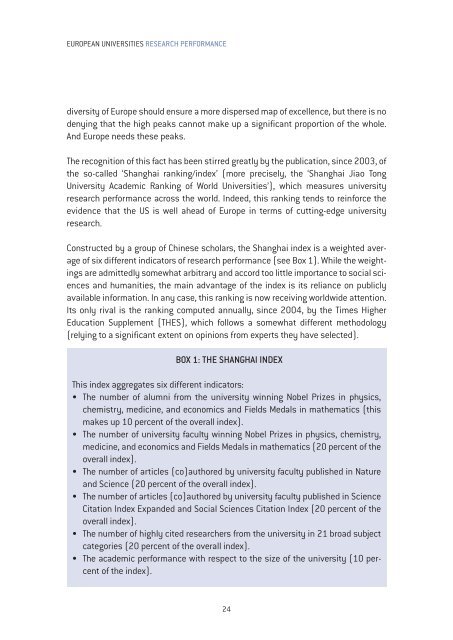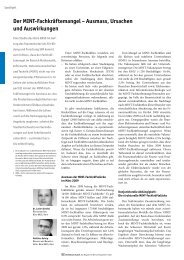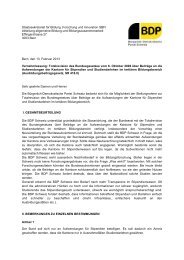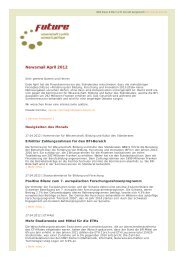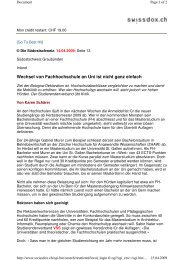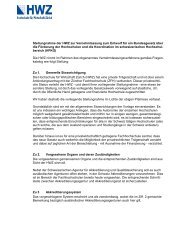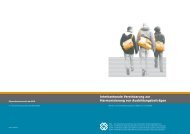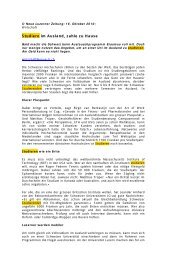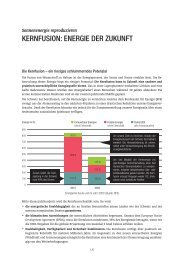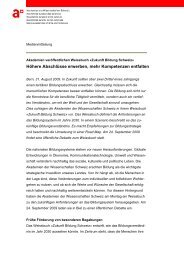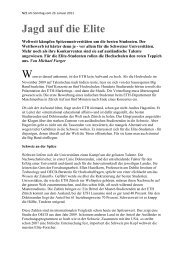Higher aspirations: an agenda for reforming European universities
Higher aspirations: an agenda for reforming European universities
Higher aspirations: an agenda for reforming European universities
You also want an ePaper? Increase the reach of your titles
YUMPU automatically turns print PDFs into web optimized ePapers that Google loves.
EUROPEAN UNIVERSITIES RESEARCH PERFORMANCE<br />
diversity of Europe should ensure a more dispersed map of excellence, but there is no<br />
denying that the high peaks c<strong>an</strong>not make up a signific<strong>an</strong>t proportion of the whole.<br />
And Europe needs these peaks.<br />
The recognition of this fact has been stirred greatly by the publication, since 2003, of<br />
the so-called ‘Sh<strong>an</strong>ghai r<strong>an</strong>king/index’ (more precisely, the ‘Sh<strong>an</strong>ghai Jiao Tong<br />
University Academic R<strong>an</strong>king of World Universities’), which measures university<br />
research per<strong>for</strong>m<strong>an</strong>ce across the world. Indeed, this r<strong>an</strong>king tends to rein<strong>for</strong>ce the<br />
evidence that the US is well ahead of Europe in terms of cutting-edge university<br />
research.<br />
Constructed by a group of Chinese scholars, the Sh<strong>an</strong>ghai index is a weighted average<br />
of six different indicators of research per<strong>for</strong>m<strong>an</strong>ce (see Box 1). While the weightings<br />
are admittedly somewhat arbitrary <strong>an</strong>d accord too little import<strong>an</strong>ce to social sciences<br />
<strong>an</strong>d hum<strong>an</strong>ities, the main adv<strong>an</strong>tage of the index is its reli<strong>an</strong>ce on publicly<br />
available in<strong>for</strong>mation. In <strong>an</strong>y case, this r<strong>an</strong>king is now receiving worldwide attention.<br />
Its only rival is the r<strong>an</strong>king computed <strong>an</strong>nually, since 2004, by the Times <strong>Higher</strong><br />
Education Supplement (THES), which follows a somewhat different methodology<br />
(relying to a signific<strong>an</strong>t extent on opinions from experts they have selected).<br />
BOX 1: THE SHANGHAI INDEX<br />
This index aggregates six different indicators:<br />
• The number of alumni from the university winning Nobel Prizes in physics,<br />
chemistry, medicine, <strong>an</strong>d economics <strong>an</strong>d Fields Medals in mathematics (this<br />
makes up 10 percent of the overall index).<br />
• The number of university faculty winning Nobel Prizes in physics, chemistry,<br />
medicine, <strong>an</strong>d economics <strong>an</strong>d Fields Medals in mathematics (20 percent of the<br />
overall index).<br />
• The number of articles (co)authored by university faculty published in Nature<br />
<strong>an</strong>d Science (20 percent of the overall index).<br />
• The number of articles (co)authored by university faculty published in Science<br />
Citation Index Exp<strong>an</strong>ded <strong>an</strong>d Social Sciences Citation Index (20 percent of the<br />
overall index).<br />
• The number of highly cited researchers from the university in 21 broad subject<br />
categories (20 percent of the overall index).<br />
• The academic per<strong>for</strong>m<strong>an</strong>ce with respect to the size of the university (10 percent<br />
of the index).<br />
24


